Hydrangeas red - description of varieties
Among all the subspecies of Hortensia, cultivated in Europe since the 14th century, the red hydrangea is the most prominent representative of this family of flowers, which is popular among gardeners. Reddening large "clouds" of inflorescences will adorn any flower garden. They look great both in composition and as a stand-alone plant.
- Red hydrangea varieties
- Wim's red
- Hot red Violet
- Red Baron
- Red Miss Hepburn
- Angel red
- Forever and Ever red
- Magical Ruby red
- Earle Senseishen (Early sensation)
- Pink lady
- Bright red
- Red beauty
- Landing features
- Timing
- Preparatory work
- Landing technology
- How to care for
- Watering
- Top dressing
- Pruning
- Preparing for winter
- Reproduction
- Diseases and pests
- Use in landscape design
- Testimonials
- Useful videos
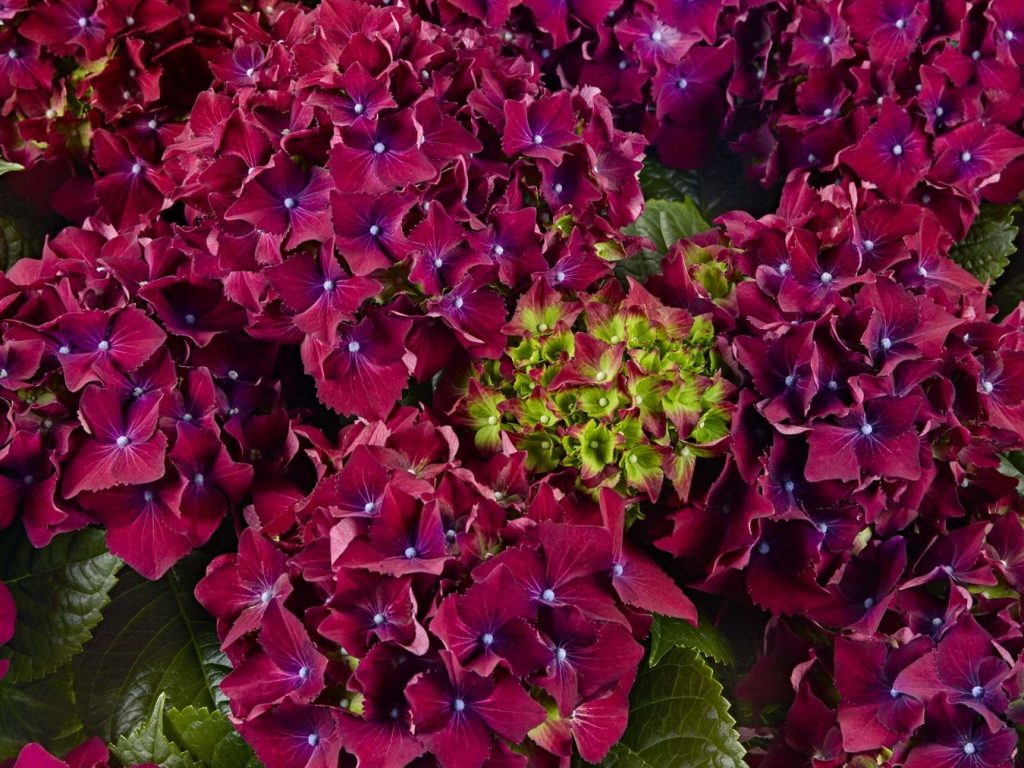
Hydrangea red
Red hydrangea varieties
There are hundreds of variations of the red form of the genus Hydrangea in the world. But most of them remain rare curiosities, known only to narrow specialists. The most widespread in the world and in Russia in particular are the following varieties.
Wim's red
Also found in the literature under the names Weems Red, Williams Red, Red Wima, Red Wings (Vince).
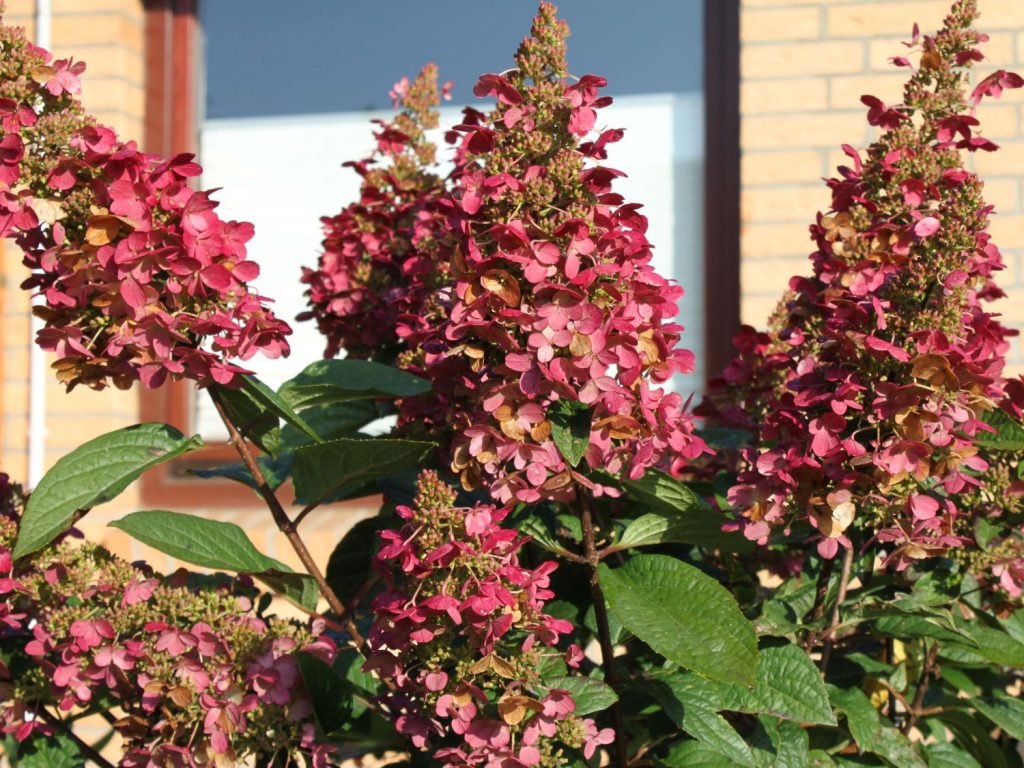
Hydrangea hot ed
One of the earliest panicle hydrangeas. It is a new garden form with strong stems that carry 30 cm bunches of flowers.
From the beginning of flowering, the color of the petals changes from white to pink, and then intensifies as they mature to a rich fiery red. The long flowering period from July to the end of September and the chameleon-like properties make the plant an excellent option for planting on the edge of a flower garden, closer to the audience.
Perhaps this is the most beautiful hydrangea of the paniculate subspecies. Flower heads can be collected for dried compositions - they are stored for a long time, keeping the color.
Hot red Violet
Gorgeous garden shape with chameleon flowers. At the beginning of flowering (July), the petals are pink. However, as they grow older, they gradually turn into a deep pink-red color with white veins and spots in the center.
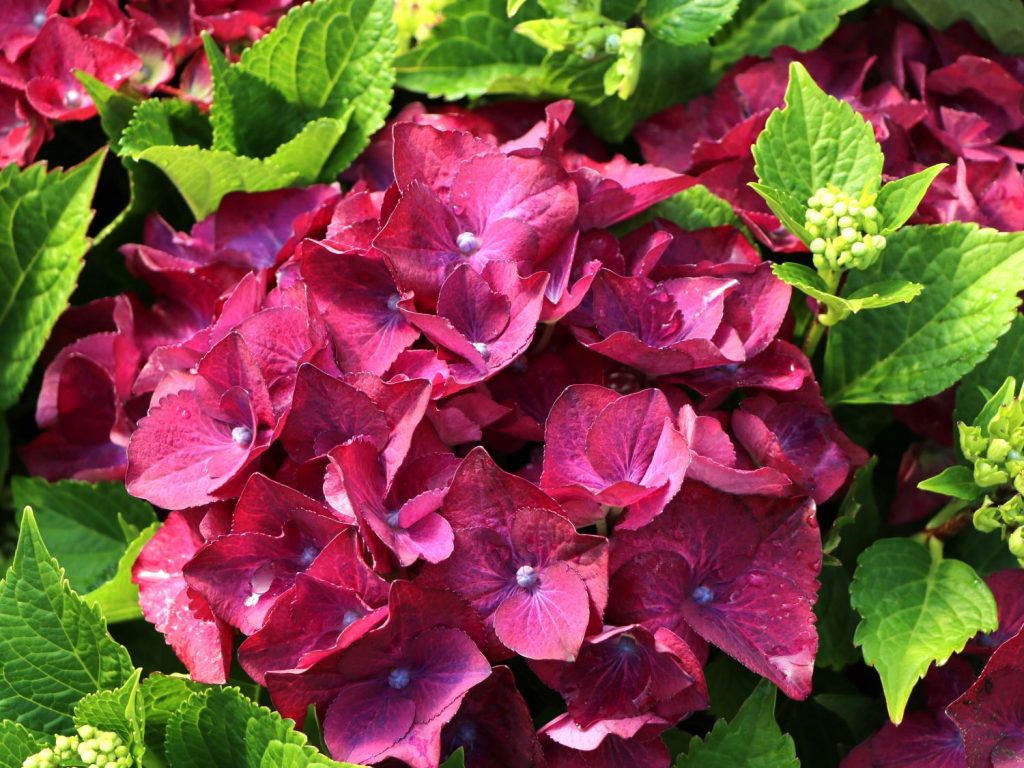
Hydrangea large-leaved hot red
It is a new compact variety (1 × 1 m) intended for outdoor cultivation. Low winter hardiness, protection is required for the winter.
Important! Color migration is most pronounced on soils with neutral pH.
Red Baron
An early, sturdy plant with strong stems and bright crimson petals. In some forms, the middle of the flower is of a delicate light green color, whitening with age.
The German hybrid of the VEG Zierpflanzen Erfurt selection is distinguished by chameleon-like properties: tubular inflorescences of a dark pink hue first turn red, and by the end of the season - purple.
The variety is not picky about care. Withstands frost 20 ° C. Blooms from July to September. The bush is medium-sized (1.2 × 1 m) with juicy green leaves.
Red Miss Hepburn
An elite variety named after Miss Katharine Hepburn.
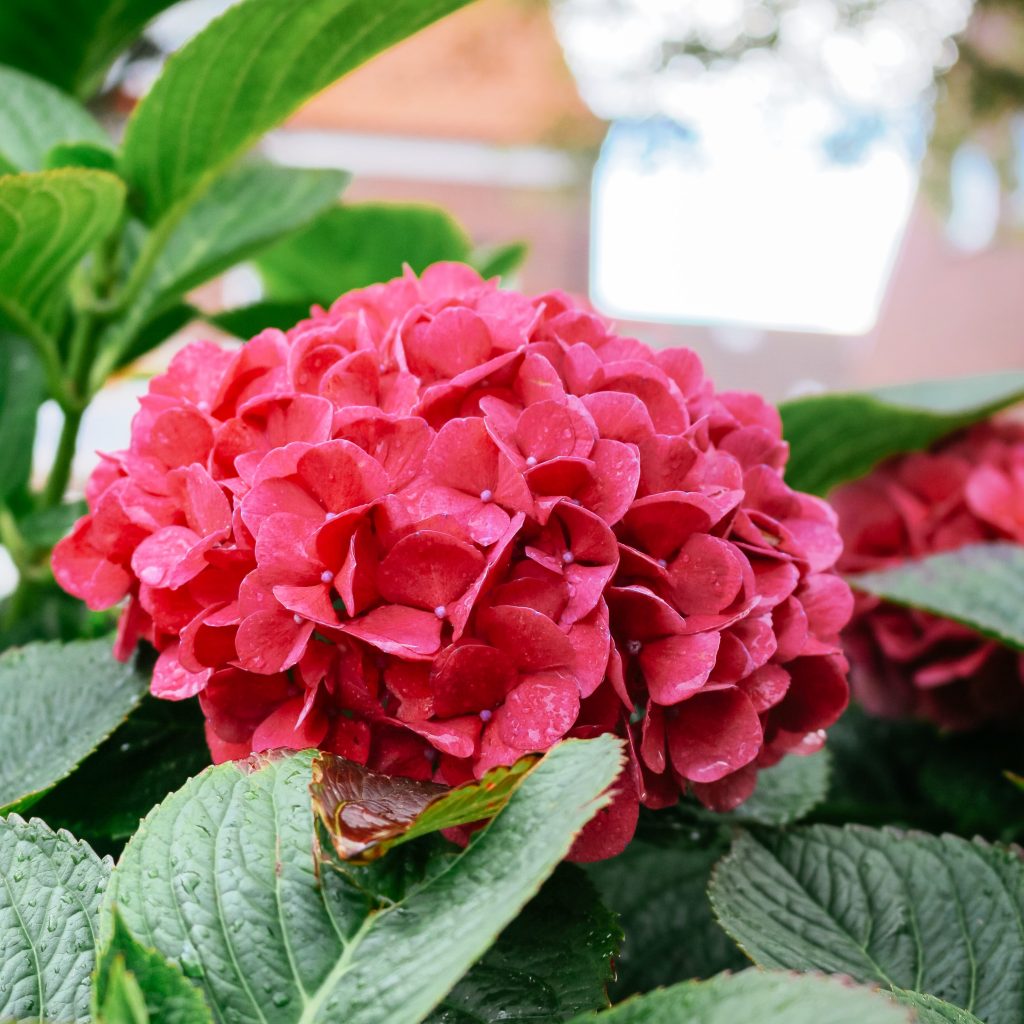
Red hydrangea
Connoisseurs call this hydrangea the most beautiful in existence.But admiration belongs to the form with bright blue-violet flowers, characterized by a deep velvety shade.
This color can only be achieved on highly acidic soils. Under normal conditions, the petals are pink. Among the positive aspects is the abundant flowering. The flower stalks dry up directly on the stems without crumbling, preserving the color shade.
Angel red
A popular group of varieties from the Black Diamond series. Red Angel subspecies differ:
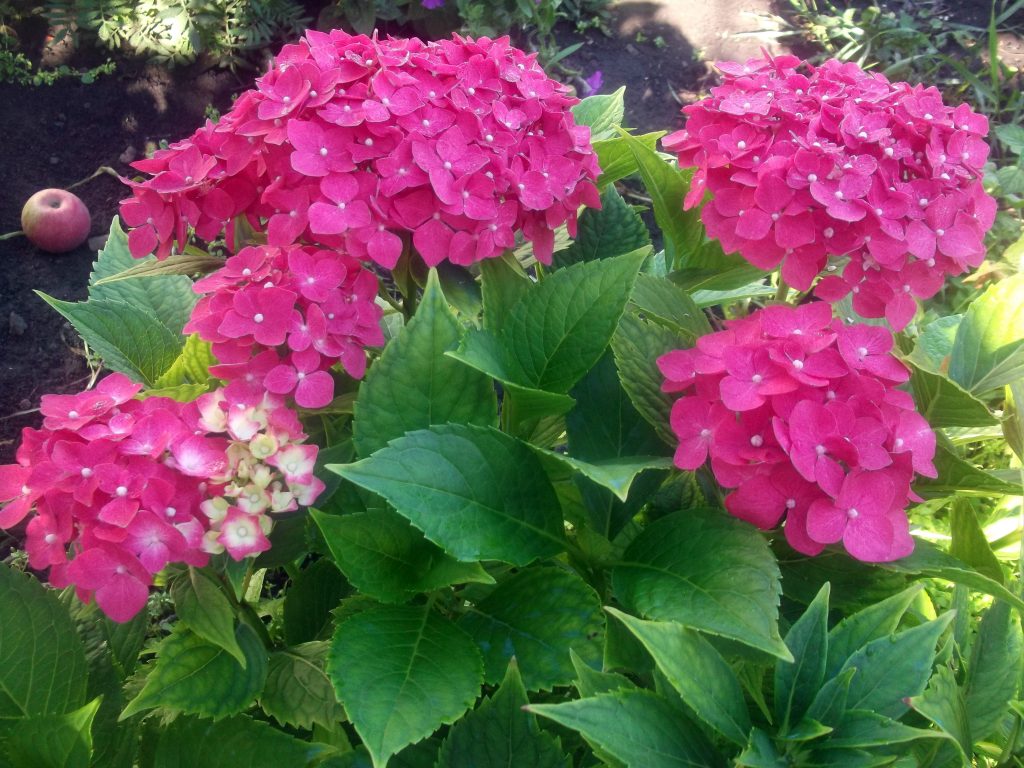
Hortense red baron
- Dark Angel purple has smooth, pointed, silky purple petals with yellow stamens that stand out against their background;
- Dark Angel red has velvety, uneven, serrated petals.
The color ranges from solid pale pink to fiery red with a white-green heart.
The subspecies is hardy and does not require special care (except for pruning). Prefers acidic soils, but grows in neutral and alkaline soils. In the latter case, the colors will be lighter. Large-leaved bush, medium-sized (1.2 × 1.2 m).
Forever and Ever red
One of the most beautiful hydrangeas of the macrophylla subspecies. Differs in bright crimson flowers with twisted petals, collected in large dense spherical inflorescences. It looks very impressive against the background of lush green foliage.
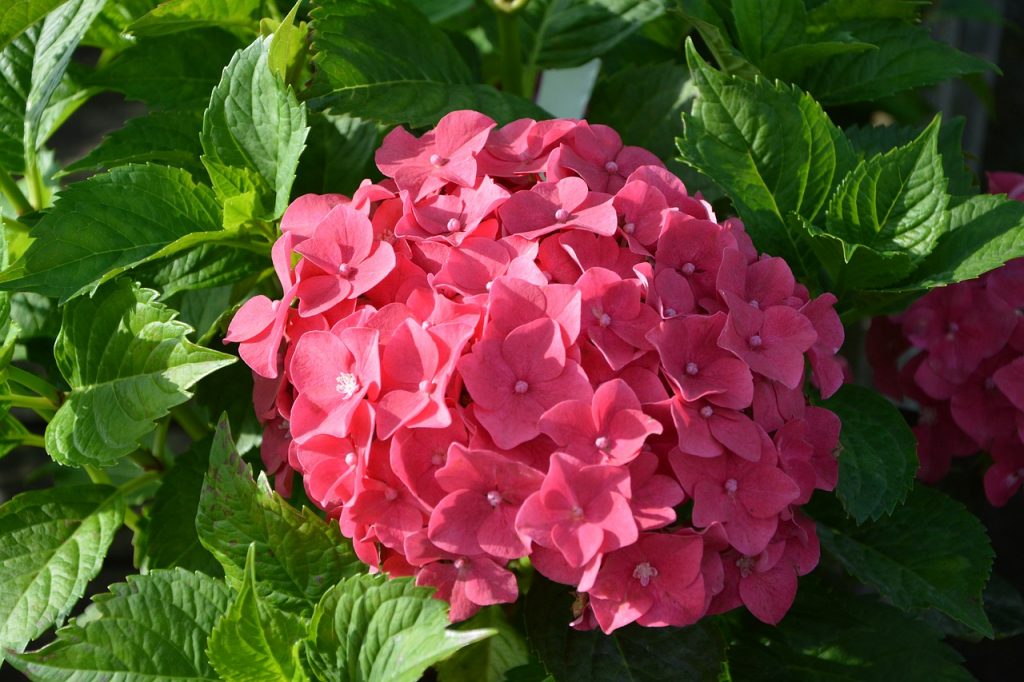
Red hydrangea varieties
As it “ripens”, the crimson color turns into purple. A similar variety with more delicate pink petals is Foreva and Eva pink.
Magical Ruby red
This hybrid of Dutch breeders with large globular inflorescences is called the owner of the most accurate red color on the RAL scale. Indeed, elastic smooth flowers surprise with a rich shade. Even the stamens are red and practically indistinguishable against the general background.
Earle Senseishen (Early sensation)
Indeed, it is a sensation in the floriculture market. Bred in the Netherlands by Darwin Plants breeders in 2005. It is one of the earliest outdoor varieties of hydrangeas. Under favorable conditions, it begins to bloom in mid-June, and until frost.
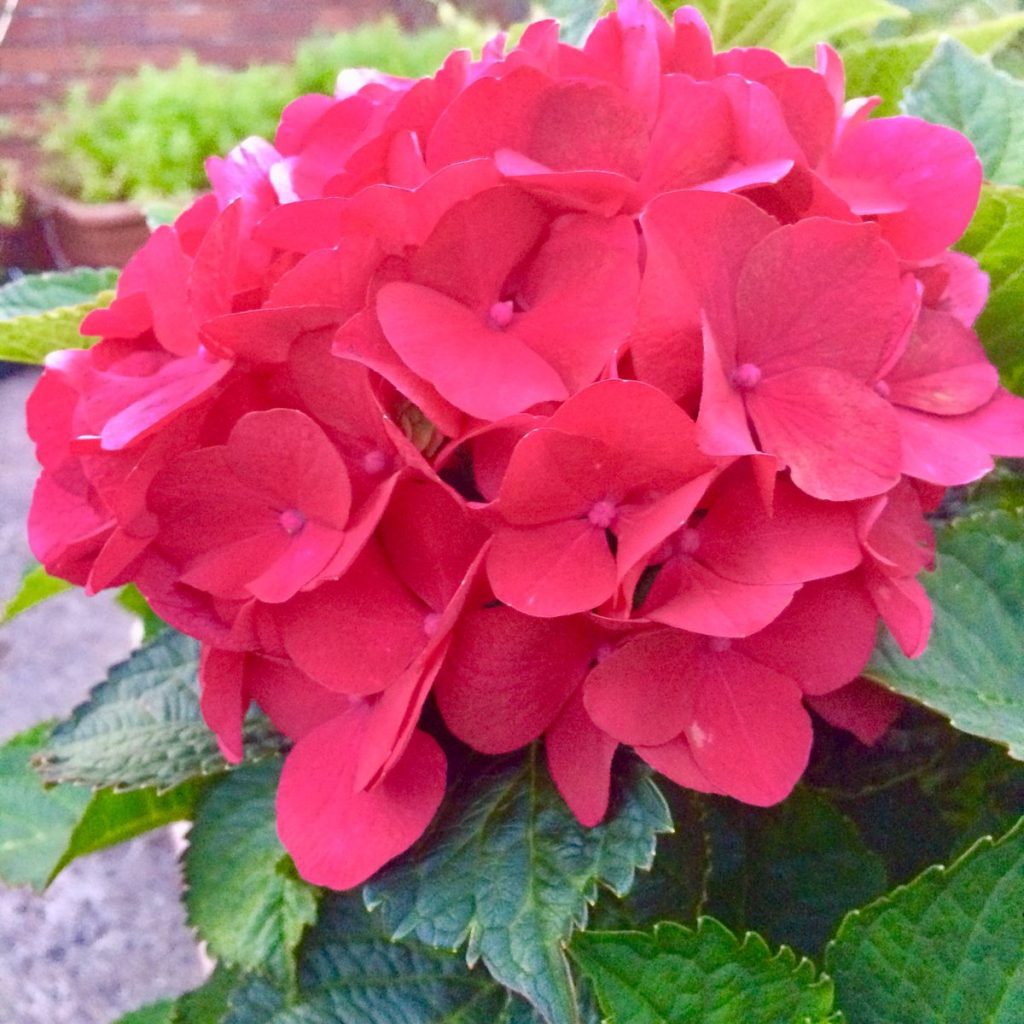
Hortense red miss hepburn
An interesting color scheme - it changes during growth, depending on the acidity of the soil. To achieve a blue hue, an acidic soil with a pH of 5.2-5.5 is required. Aluminum sulfate will help to increase acidity.
For pink or purple-red shades, the soil should be alkaline, that is, pH 6.0-6.2. It can be obtained by adding dolomite lime powder.
Pink lady
A bright representative of the panicle hydrangea. The bush has a spreading fan-shaped crown up to 2 m in diameter. Large sterile and small fertile flowers are collected in huge 40 cm cone-shaped inflorescences, reminiscent of a broom.
At the beginning, the petals are white, by the end of July they begin to turn unevenly pink from the edge to the center, and by September they become cherry red. The flowering period is from late June to September. It is considered one of the most elegant varieties in England.
Bright red
The variety is distinguished by reverse color migration: at the beginning of flowering, the petals have a bright rich red color. But closer to autumn, they acquire a greenish tint in the central part. Long-lived plant - able to delight with its beauty up to 50 years. Differs in high resistance to diseases and average winter hardiness (up to -23˚C). Botanists recommend not to cut off dried-up flower stalks in autumn - they act as a heater.

Hortense red miss hepburn her
Red beauty
An interesting variety with a relatively compact bush (0.8 × 1.2 m) and at the same time large, abundant, dense spherical inflorescences, reaching a diameter of 20 cm. The color of the flowers gradually changes from light green to red. To make the range more saturated, it is necessary to acidify the soil, the more the better.
The plant is often chosen as a potted plant. In a container, they grow up to 60 cm in height and 50 cm in width.The plant pleases the eye with generous flowering from July to October.
Landing features
Hydrangeas are sprawling flowers reaching up to 3 m in diameter. When planting, the distance between individual specimens is determined by morphological properties.
Treelike subspecies have the widest crown - 10-year-old representatives grow to the size of a small tree.
Large-leaved forms are twice as low in height, but approaching one and a half meters in width. There are curly subspecies reaching 3 floors of the house. Accordingly, the minimum distance, depending on the variety, ranges from 90 cm to 3 m.
Timing
Typically, plants are planted in two seasons - fall or spring. In summer, it is too hot for this, especially since drought can roll, and Hortensia likes humid air.
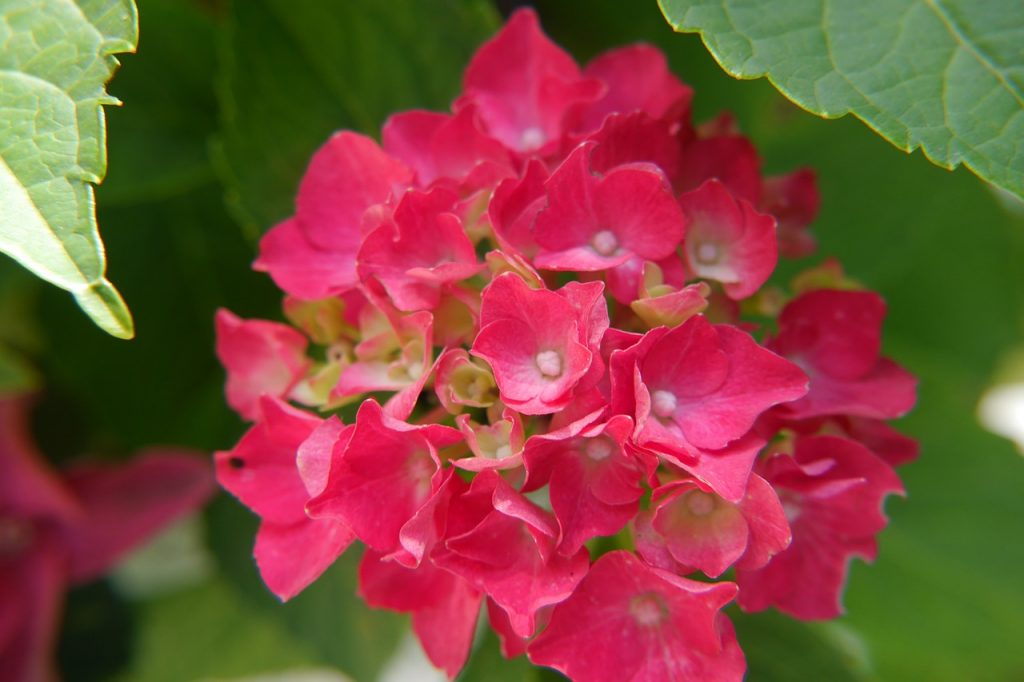
Hortense Red Miss
In winter, there is too little sunlight in the rooms for harmonious development. And again - dry air from the batteries.
Preparatory work
Hydrangea grows everywhere. Indeed, she prefers sunny places with partial shade, but it grows well in the shade. Unless the colors will be less vivid.
Although Hortensiae are respectful of water and love slightly damp soils, during the rainy season, fungal infections of the roots and greenery are possible. If the groundwater is shallow somewhere, it is advisable to equip a drainage system at the proposed landing site.
When choosing a plant for a garden, first of all, you need to pay attention to its color and elasticity. Pale leaves, sluggish young shoots, the presence of incomprehensible specks and fluffy bloom should alert. Most likely, this instance is sick. It is not even the fact that the seedling may die that is dangerous. It is able to infect neighboring flowers with fungal or bacterial infections, and the entire area with rust.
No special preparation is required before boarding. According to the botanical description, hydrangeas are strong, life-loving plants, they easily take root and take root in a new place. However, it is not superfluous to treat the roots and green mass with a fungicide for prevention, as well as to strengthen the immune system with immune drugs - inductors.
"Symbiont-universal", "Immunocytofit", "Novosil" have proven themselves well. A new generation has appeared on the basis of chitosans (chitin derivatives), for example, "Narcissus", "Slox-eco Artemia", "Ecogel". They are practically non-toxic and, in combination with inductors, prevent the development of diseases. Humates "Zircon", "Silk" and "Epin" stimulate growth.
Landing technology
- Dig a hole slightly deeper than the root ball and 2-3 times wider.
- Place the seedling in the hole and fill it halfway with soil. Drizzle. After soaking up the water, fill the rest of the hole with soil.
- Water thoroughly again so that the voids between the roots are filled with earth.
How to care for
Most hydrangea subspecies thrive in organic-rich, breathable, slightly damp soils. If the land is poor in nutrients, compost or rotted manure must be added. When grown on dense clay, the soil must be loosened regularly.
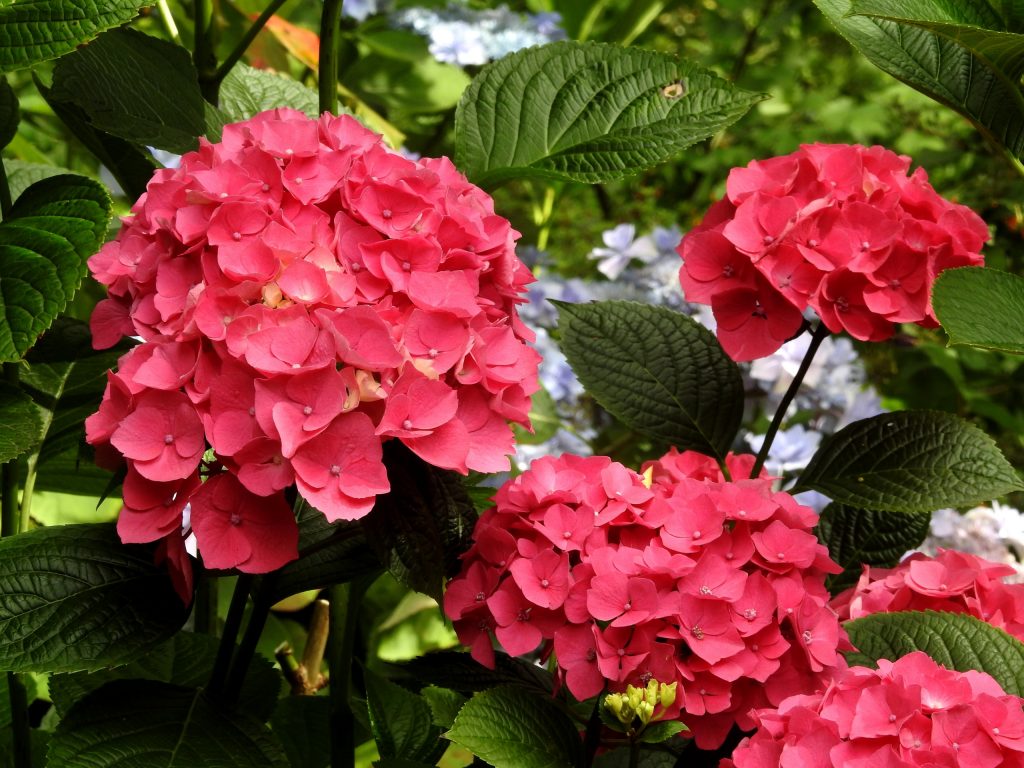
Hydrangea paniculata red wings
Watering
As a rule, an adult plant has enough moisture that falls out with precipitation. But for young seedlings, everything is different. For 1-2 years after planting and during the dry season, hydrangeas require a lot of water. Leaves will begin to wilt if the soil is too dry.
Top dressing
If the soil is rich in humus, no additional nutrients are required. If the soil is light, sandy, you can feed the plants once a year in early spring or at the beginning of growth (April-May). An excess of fertilizers stimulates the growth of green mass to the detriment of flowering.
Pruning
The most common among gardeners are large-leaved hydrangeas (H. macrophylla), serrated (H. serrata), oak-leaved (H. quercifolia), petiolate (H. Anomala subsp. Petiolaris).
They are pruned after the flowering season. In these forms, flowers form on the stems of the previous season.
A number of subspecies of hydrangeas - paniculata (H. Paniculata), treelike (H.arborescens) - trimmed before bud formation. These varieties bloom on the stems of the current season.
If the plant is old, unkempt or damaged, it is advisable to prune all stems to the base. Gardeners will lose their bloom in the coming season, but they will rejuvenate the hydrangea for many years to come.
Preparing for winter
The winter hardiness of hydrangeas is average - not all of them are able to overcome the severe temperature barrier of Siberia, the Urals and the Russian North. Severe frosts and temperature fluctuations, when the thaw is abruptly replaced by cold weather, can induce a favorite bush.
Therefore, in the fall, the land around the hydrangeas is covered with a 30-40 cm layer of mulch: bark, leaves, needles or straw. Loose compost (10-20 cm) is also suitable.
Gardeners, if possible, cover the plant with leaves or whole straw. For this, a simple cage is constructed from wire or slats covered with a coarse mesh. This is especially useful in the northern regions.
Reproduction
Hydrangeas are easy to grow by cuttings - they take root quickly.

Hydrangea ed
- On an adult bush you like (strong, blooming well, not sick), find a branch that has just grown, but has not yet bloomed. The new sprout is lighter in color than the old one. At the same time, the stem is flexible, not stiff.
- Move 10-13 cm down from the tip of the branch and make a horizontal cut. At least 3-4 pairs of leaves should remain on the cut branch.
- Remove the bottom pair of leaves from the cutting - it is easier for the roots to germinate from the leaf nodes. If the stalk is long, you can cut off 2 pairs of leaves. In this case, at least 2 pairs of leaves from above should remain intact.
- If the leaves are large, it is advisable to cut them in half by removing the tip. This prevents them from rotting when they come into contact with the damp sides of a plastic bag that is placed over the stem to retain moisture.
- It is not necessary, but desirable to treat the lower leafless part of the cuttings with a preparation to accelerate root formation and an antifungal fungicide for plants. Both are sold at a hardware store or garden store. This stimulates the rooting process and prevents decay.
- Prepare a flower pot and fill it with moistened potting soil. Plant a stalk in it, deepening to the first pair of remaining leaves. Water lightly to get rid of the air gap around the stem.
- Put a plastic bag on top of the pot. It should be loose and not touching the stem. It is logical to make a simple frame in advance, for example, from Chinese chopsticks.
- Place the pot in partial shade in a warm place, protected from drafts and wind currents.
- Air the mini greenhouse every few days to make sure the seedling doesn't rot. Water as the topsoil dries up.
The plant will take root in a few weeks. You can check for roots by gently pulling on the handle. If resistance is felt, then the root system has formed.
Diseases and pests
When grown outdoors, flowers are susceptible to the following misfortunes:
| Problem | Decision | Prophylaxis |
| Gray rot | Caused by the fungus Botrytis cinerea. Destroy the affected areas or the plants themselves. Treat with systemic fungicides (Topsin, Fundazol) or a solution of copper sulfate and household soap. | Avoid waterlogging, do not thicken the planting, provide ventilation. Remove debris and cut (dead) parts of the plant in time. |
| Powdery mildew | The fungus compromises the immune system. Destroy the affected units. Organic (low-toxic) fungicides containing potassium bicarbonate, sulfur, lime, neem tree oil (margoza) are effective. | Do not put stalks, leaves, fruits affected by powdery mildew in the compost. |
| Rust | A fungal disease that can be easily identified by rusty spots. Destroy the affected parts or the plant itself. Dislikes sulfur and preparations based on it. Dies from such fungicides as "Strobi", "Poliram", "Cumulus", "Abiga-Peak". | In the spring, treat with colloidal sulfur, Bordeaux liquid. |
| Spots on the leaves | Caused by fungi and bacteria. Remove diseased leaves. Spray with fungicides. | Water in moderation. |
| Slugs | Molluscs eat leaves. Easy to assemble with trap containers filled with beer or mash (a combination of yeast, molasses, corn and wheat flour). Avoid lime, ash, ground eggshells, coffee grounds, pine needles. They can be sprinkled around the bush. | Remove garbage, boards, branches, bricks from the site, under which the slugs are hiding. Mowing weeds. |
Use in landscape design
Hydrangeas are excellent for a variety of garden areas, from group plantings to curb shrubs and containers. There are plenty of varieties. Moreover, every year breeders offer something new.
Curious! Large-leaved hydrangea can change color. Bushes over 2 years old are suitable for correction.
It is easier to change the blue color of the petals to pink than pink to blue. This is done by changing the acidity of the soil: pH less than 5.5 gives blue flowers, soils with a pH above 5.5 give pink flowers, and white flowers are independent of pH.
Testimonials
Hydrangeas are highly valued by flower growers. It is enough to walk through the private sector to notice that these plants grow in many. People like both the flowers themselves, crowned with large caps of inflorescences in the season, and the ease of care and reproduction.

Hydrangea large-leaved ed miss hepburn
Today there are many varieties with a variety of colors, crown heights and widths, with an extended flowering period. Flowers are suitable for those who suffer from allergic reactions to pollen. Hydrangea does not provoke an immune response in the body.
Among the disadvantages, florists distinguish mediocre frost resistance. Sometimes young shoots suffer from cold weather, and sometimes the whole bush freezes out. Winter protection requires time, additional materials and labor.

